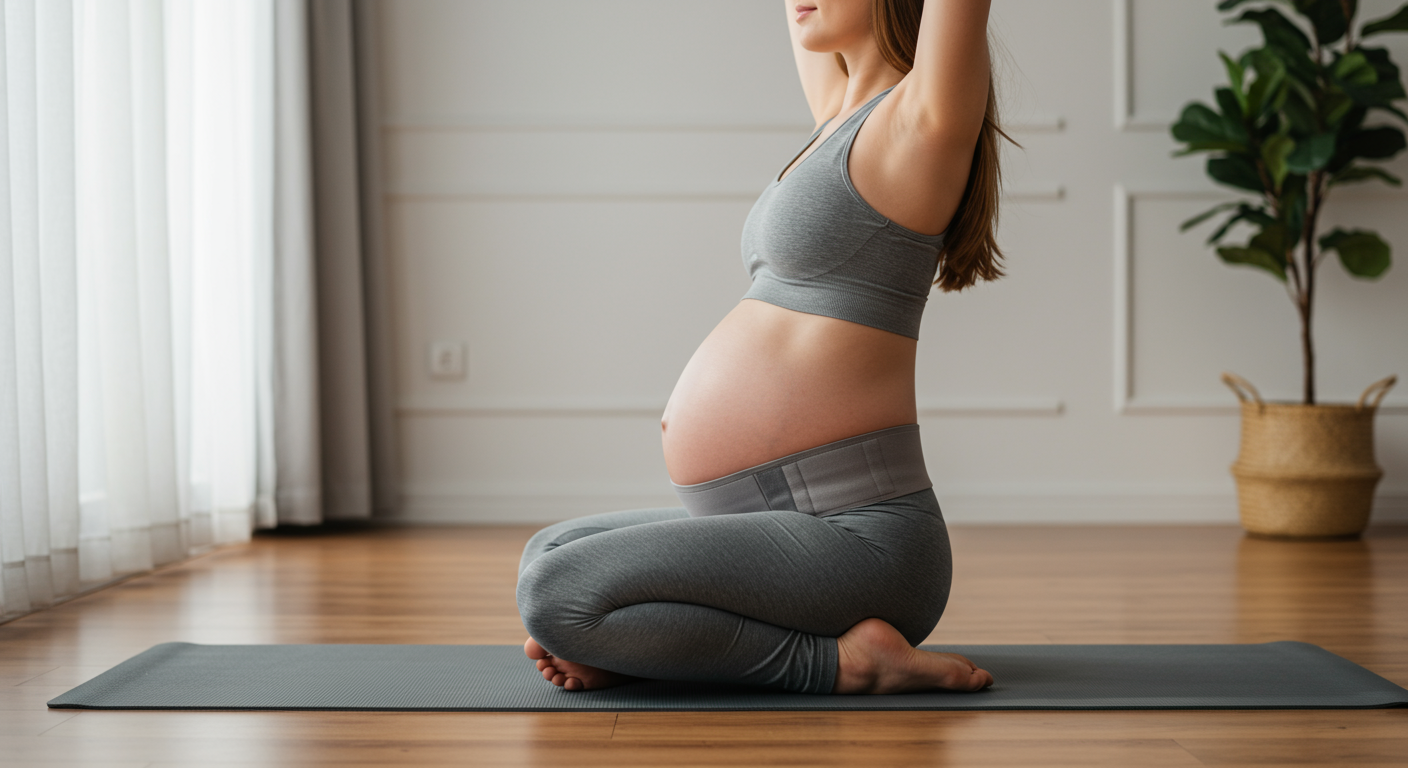Maternal Wellness: Complete Guide to Pregnancy and Postpartum Abdominal Support
Pregnancy and childbirth bring profound changes to a woman’s body, particularly the abdominal region. Understanding when and how to use abdominal support during these transformative times can significantly improve comfort, recovery, and overall well-being.
Understanding Abdominal Changes During Pregnancy

First Trimester (Weeks 1-12)
- Minimal visible changes
- Hormonal effects on ligaments
- Early round ligament pain possible
- Core muscles beginning to adapt
Second Trimester (Weeks 13-27)
- Visible belly growth
- Increased pressure on back
- Abdominal muscles stretching
- Center of gravity shifting
- Potential for diastasis recti beginning
Third Trimester (Weeks 28-40)
- Maximum abdominal expansion
- Significant postural changes
- Increased pelvic pressure
- Breathing changes
- Preparation for delivery
Prenatal Support Options
Maternity Support Belts
Benefits:
- Reduces back pain
- Supports belly weight
- Improves posture
- Decreases pelvic pressure
- Allows continued activity
Key Features:
- Adjustable sizing for growth
- Breathable materials
- Side support panels
- Easy bathroom access
- Machine washable
Belly Bands
Advantages:
- Gentle support
- Seamless under clothing
- Extends regular clothing wear
- Provides warmth
- Light compression
Best For:
- Early to mid-pregnancy
- Mild discomfort
- Fashion coverage
- Light activity support
When to Start Using Prenatal Support
Common Indicators:
- Lower back pain
- Round ligament pain
- Pelvic girdle pain
- Difficulty with daily activities
- Healthcare provider recommendation
- Multiple pregnancy
- Previous pregnancy complications
Timing Guidelines:
- Some women need support as early as 20 weeks
- Most benefit from support in third trimester
- Individual needs vary greatly
- Always consult your healthcare provider
Safe Usage During Pregnancy
Do’s:
- Wear over clothing or thin layer
- Adjust as belly grows
- Remove if feeling lightheaded
- Take breaks from wearing
- Listen to your body
- Keep multiple sizes available
Don’ts:
- Wear too tightly
- Sleep in support belt (unless advised)
- Ignore discomfort
- Replace medical care
- Use if baby’s movement decreases
Postpartum Recovery Support

Immediate Postpartum (0-6 weeks)
Vaginal Delivery:
- Can often begin support within days
- Start with gentle compression
- Focus on comfort over tightness
- Support during breastfeeding
- Aid in posture improvement
Cesarean Delivery:
- Wait for doctor’s approval (usually 1-2 weeks)
- Protect incision site
- Reduce pressure on sutures
- Support during movement
- Aid in pain management
Extended Postpartum (6 weeks – 6 months)
- Gradual increase in support level
- Focus on muscle retraining
- Diastasis recti management
- Core rehabilitation support
- Return to exercise assistance
Types of Postpartum Binders
Traditional Wrap Style
- Maximum adjustability
- Even compression distribution
- Customizable fit
- Requires assistance initially
- Most supportive option
Velcro Closure Binders
- Easy self-application
- Quick adjustments
- Good for C-section recovery
- Multiple compression zones
- Convenient for nursing
Corset-Style Support
- Structured support
- Back support included
- Fashion-forward options
- Longer torso coverage
- Special occasion wear
3-in-1 Systems
- Belly support
- Waist training
- Pelvis support
- Comprehensive recovery
- Adjustable components
Diastasis Recti and Support
Understanding Diastasis Recti:
- Separation of abdominal muscles
- Common in pregnancy
- Varies in severity
- Requires specific support
- May need specialized therapy
Support Strategies:
- Splinting during exercises
- Consistent binder use
- Proper movement techniques
- Targeted exercises
- Professional guidance
Breastfeeding Considerations
Nursing-Friendly Features:
- Easy up/down adjustment
- Doesn’t interfere with positioning
- Breathable materials
- Quick release options
- Maintains support while nursing
Positioning Tips:
- Loosen before feeding
- Support back during nursing
- Readjust after feeding
- Consider nursing pillow compatibility
- Maintain good posture
Exercise and Movement
Safe Postpartum Exercises:
Weeks 0-6:
- Pelvic floor exercises
- Gentle breathing exercises
- Walking as tolerated
- Basic pelvic tilts
- Gentle stretching
Weeks 6-12:
- Modified core exercises
- Low-impact cardio
- Postnatal yoga
- Swimming (if cleared)
- Light strength training
After 12 Weeks:
- Progressive core work
- Return to regular exercise
- Higher intensity options
- Sports-specific training
- Full fitness routine
Choosing the Right Support
Pregnancy Support Selection:
- Measure at widest point
- Consider growth potential
- Check return policies
- Read reviews from similar body types
- Prioritize comfort
Postpartum Support Selection:
- Account for swelling
- Consider delivery type
- Think about lifestyle needs
- Plan for size changes
- Invest in quality
Common Concerns Addressed
“Will it harm my baby?”
- Properly fitted support is safe
- Should not restrict baby’s movement
- Supports your body, not baby
- Always consult healthcare provider
“How long should I wear it?”
- Varies by individual
- Typically 6-8 hours daily
- Gradual weaning recommended
- Listen to your body
- No set timeline
“Can I sleep in it?”
- Generally not recommended during pregnancy
- Some postpartum use approved
- Comfort is key
- Follow medical advice
Cultural Practices and Modern Medicine
Traditional Practices:
- Belly binding in many cultures
- Bengkung belly binding
- Mexican faja use
- Japanese sarashi
- African wrap techniques
Modern Integration:
- Combining tradition with medical knowledge
- Respecting cultural practices
- Evidence-based modifications
- Honoring family traditions
- Safe adaptation methods
Warning Signs to Stop Use
During Pregnancy:
- Decreased fetal movement
- Difficulty breathing
- Dizziness or faintness
- Numbness or tingling
- Increased contractions
- Any unusual symptoms
Postpartum:
- Increased bleeding
- Severe pain
- Infection signs
- Breathing difficulties
- Circulation issues
- Delayed healing
Long-Term Recovery
Realistic Expectations:
- Recovery takes time
- Every body is different
- Progress isn’t linear
- Celebrate small wins
- Focus on function over appearance
Continued Support Needs:
- Some need support longer
- Subsequent pregnancies may differ
- Age affects recovery
- Multiple births impact timeline
- Individual variation is normal
Professional Resources
Healthcare Team:
- Obstetrician/Midwife
- Physical therapist
- Pelvic floor specialist
- Postpartum doula
- Lactation consultant
Creating Your Support Plan
Questions for Your Provider:
- When can I start using support?
- What type do you recommend?
- How many hours per day?
- Any activities to avoid?
- When to discontinue use?
Remember, pregnancy and postpartum recovery are unique journeys. What works for one woman may not work for another. Always prioritize your comfort and safety, and don’t hesitate to seek professional guidance when needed. Your body has done amazing work—give it the support it deserves.




